 Much
of the UK's electricity is now generated by using natural gas and
although coal remains a significant fuel, the "going for gas"
trend has made Britain dependent on it to "keep the lights
on". Now that North Sea natural gas production has passed its peak,
the UK, once a net exporter, now augments its indigenous supplies with
imports.
Much
of the UK's electricity is now generated by using natural gas and
although coal remains a significant fuel, the "going for gas"
trend has made Britain dependent on it to "keep the lights
on". Now that North Sea natural gas production has passed its peak,
the UK, once a net exporter, now augments its indigenous supplies with
imports.
An important constituent in the UK, and the world, energy market is LNG or liquefied natural gas. Converting natural gas to a liquid and back again to gas, transporting it and finally storing the LNG is the stuff of engineering prowess. But in the rush to fill the growing energy gap, are governments taking the time to fully assess the potential hazards? A case in point off the southwest coast of Wales suggests they are not.
Going (overseas) for gas
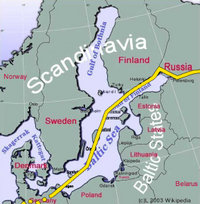
Pipelines under the North Sea bring LNG in its gaseous form from Norway and via the European network from Russia. Although in Autumn 2006 a new pipe link from Norway landed gas at Easington in County Durham, reliance on this and other feeders is seen as insecure and subject to disconnection. For assurance that supplies will be maintained, alternatives are needed.
So recourse is made to imports of liquefied natural gas (LNG) coming from many far-flung places. At export terminals, the gas is purified and liquefied for ocean transport in specialised tankships to import terminals, where the liquid gas is stored regasified and compressed for entry into the gas pipeline distribution network
|
UK import terminals
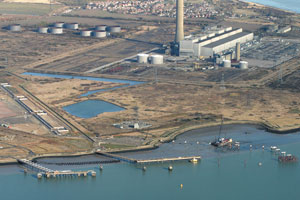
LNG was first imported into the UK at Canvey Island in the Thames Estuary, but this ceased in 1994 due to competition from North Sea gas. Across the estuary at Grain on the Medway are existing LNG storage facilities and a favourable sea approach for the largest LNG tankships to berth. Grain, like Canvey Island, also has an existing connection to the national gas pipeline network and both are close to the main centre of demand in the UK. Both terminals are now subject to expansion as major LNG import terminals.
Although these two terminals may well be subject to safety problems, there are two new terminals under construction in Wales at Milford Haven that need scrutiny because of their propensity to create a catastrophe.
Milford Haven
There are two LNG import terminals under construction in Milford Haven harbour, Dragon LNG on the site of the Petroplus oil products storage depot and Qatar Petroleum/ExxonMobil, at South Hook on the site of a closed refinery. Two oil refineries are still operating, Total located inland to the North-West of Milford Haven and Chevron-Texaco on the South bank opposite Milford Haven.
The appropriately named Dragon LNG project is the most pressing for analysis as it is under construction at the Petroplus oil storage depot between the North shore and the village of Waterston. To the East lies Neyland township, across the water from which is Pembroke Docks, while to the West is Milford Haven town.

Irish Ferries operates a Roll-On Roll-Off car ferry from Pembroke Docks to Rosslare twice daily, passing the two LNG and the two oil refinery terminals four times a day.
The estuary where the Dragon LNG terminal is situated is around 1 km wide, but the dredged channel adjacent to it is only about 200 metres wide. This means that when the ferry passes the LNG terminal, a 45 metres wide LNG tankship is unloading and another ship is approaching Pembroke Dock, the clearance between the three ships will be tight.
Down the estuary to the West on the South shore is the Chevron-Texaco terminal and thereafter on the North bank is the Total Marine Terminal, serving the inland refinery. Further down still on the North bank, the South Hook terminal for the Qatar Petroleum/ExxonMobil LNG terminal is under construction.
The port's business increased in 2005 by 15% to handle 37 million tonnes of cargo, mostly oil. A general cargo terminal operates at Pembroke Dock. Milford Docks, by Milford Haven town, has a dry dock and repair facilities for vessels and is a base for deep sea trawlers. The Haven is also a busy yacht harbour and there are several marinas and sailing clubs.

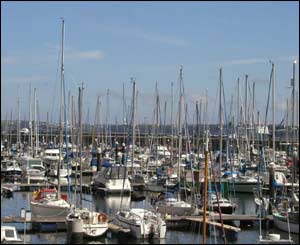
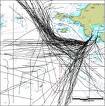
Immediately to the West of the Petroplus terminal is what the Port Authority calls a "pinch point" with inward and outward vessels constantly changing their courses and aspects. This is compounded by strong winds and tides. The channel is narrow just to the West of the Petroplus terminal and deep draught vessels must be kept strictly on track.
The introduction of two LNG tankship terminals with potential hazardous consequences activity into this busy harbour requires careful consideration. The Dragon LNG terminal will receive one 150,000 cubic metre tankship once a week, while the South Hook terminal will receive one tankship every two and a half days, including the biggest which can carry 265,000 cubic metres of LNG.
LNG tankships
The LNG is stored on board in two types of insulated container, spherical or double walled membrane. The contents remain cold by the evaporative cooling from a constant boil-off of gas due to the heat ingress from the containment walls.
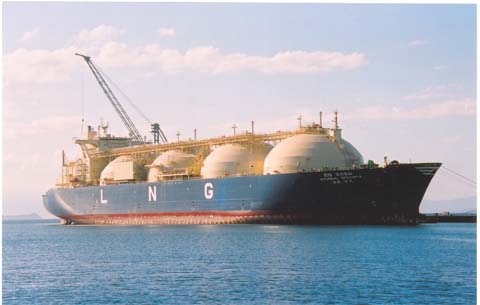
A typical tankship of 90,000 tonnes gross deadweight will be 285 metres long, have a 43 metres breadth and draw 12 metres with a cargo capacity of 140,000 cubic metres of LNG in four tanks. The liquid cargo is discharged by means of eight submersible pumps, i.e., two per tank. Each tank has an auxiliary pump for standby use.
The complex on-board operation is performed with compressors, heaters and vaporisers. The ship is equipped with inert gas and nitrogen plants.

Normally a "heel" of liquid gas is left in the tanks when the tankship returns in ballast. From empty the tanks are subject to "inerting" with inert gas or nitrogen followed by "gassing up" with vapour and cooling down prior to loading with LNG. To empty the tanks for maintenance, requires a sequence of "warming up", inerting and aerating.
The filling and emptying regime is crucial as because of the length of the ship unequal loads in the four tanks can cause "hogging" of the hull with unacceptable bending stress.
The tankship is provided with a control system, which when discharging at the terminal has to be integrated with the on-shore systems. This means that the control systems on tankships of diverse origins have to be compatible with those on-shore when transferring the contents.
LNG Storage on-shore
There are several storage tanks arrangements world-wide. In the UK above- ground tanks are preferred, while in Japan tanks are set "in-ground" with just the top domes showing, but now use a completely buried underground type. They typically contain 160,000 cubic metres, which means that the external diameter and the overall height to the top of the dome are around 77 and 50 metres respectively.
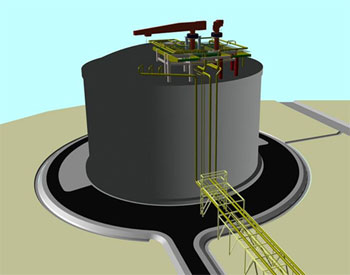
The above ground storage tanks are constructed of a reinforced concrete shell and dome containing an inner nickel steel shell with insulation between. The unloading of the LNG from the tankship is performed with all the pumps in the individual tanks running to avoid "hogging" the hull at a rate commonly of 12,000 cubic metres per hour over 12 - 14 hours, with the whole operation taking around 24 hours. The ship-to-shore connections consist of unloading arms and lines, with additional arms to accommodate return vapour.
The LNG entering the storage tank displaces the vapour head, which is returned to the ship tanks by a balance line, augmented if necessary by a blower. Heat ingress into the tank creates "boil-off" gas which is extracted by a boil-off gas compressor and injected into a recondenser. In this it is mixed with the liquid gas extracted from the tank by its send-out pumps on its way to the regasifiers for entry into the gas pipeline network.
Storage tanks are fitted with relief valves or bursting discs to avoid overpressure as the reinforced concrete construction of such large dimensions can only take moderate overpressure. The relief valve outlets are piped to a vent stack.
A significant problem associated with the storage of successive unloading of LNG is "rollover". This refers to the rapid release of vapour from a storage tank caused by stratification by separate layers of different LNG densities due to differing compositions. LNG can arrive from a variety of sources and as this can cause a rapid boil-off, the tank relief valves must be sized to accommodate it to avoid tank failure.
Dragon LNG
Dragon LNG is erecting two 160,000 cubic metres capacity tanks set in a hollow on top of a hill which originally levelled off at 50 metres above sea level. The hollow has varying depths, of which the least is 13 metres and affords 200% containment for the contents of one of the tanks.
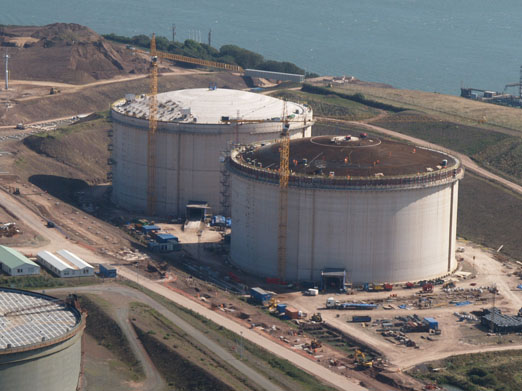
Taking into account the height of a tank and its setting in the hollow, the static pumping head from the bottom of the ship's tanks to a filling point just below the dome of the storage tanks is around 75 metres. The jetty unloading arms connect to two 760 mm diameter pipelines to take the LNG some 700 metres up to the top of the tanks. The pipes are laid on a pipetrack cut into the cliff and reach to the gasification area behind the tanks. From there they will be extended to fill the tanks from above, avoiding entries in the sides.
The pumping rate at Dragon LNG is likely to be lower than elsewhere when the 75 metres static head is taken into account, increasing the overall time of the ship at the terminal.
Hazard assessment
In 2003 a team of experts considered the hazard potential of releases of LNG from the storage tanks, from the regasification area and from a moored tankship. Unless the gas contains higher carbons, such as ethane, propane and butane, tests have shown that, in the open, the gas burns when ignited but does not explode. Depending on the quantity spilled, a fireball can result, but unless released in a confined space a vapour cloud explosion was considered unlikely.
Various scenarios were considered such as failure of a storage tank, rupture of one of the pipelines, a major release in the gasification area and a major failure of the pipeline from the regasification area to the plant boundary, which is adjacent to the hamlet of Waterston. The possibility of liquid "plunging" over the cliff on to the water surface below the tanks was considered and therefore the size of the hollow was defined in an attempt to prevent this happening, though a Northerly wind would blow the contents over the edge.
It was calculated that pool fires could encompass the edges of several communities and fill the estuary. Moreover, the new plant in the regasification areas might provide the confinement needed to create a vapour cloud explosion. The two projects, Dragon LNG at Petroplus oil depot and Qatar Petroleum/ExxonMobil at the redundant South Hook refinery, were nevertheless approved.
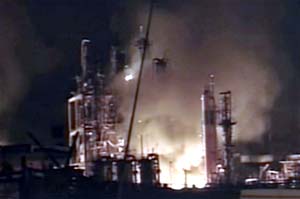
Events subsequent to the approvals
In 2004 there was a vapour cloud explosion at the Skikda LNG export terminal in Algeria and in 2005 at the Buncefield oil depot near Hemel Hempstead in Hertfordshire.
The Skikda explosion killed 27 employees but was confined to the site. There was an initial report into the incident in 2004, but since then no definitive assessment of the cause has been published. It has emerged however, that the Algerian LNG contains 9% ethane, 2% propane and some 0.7% butane, which would make a vapour cloud explosion likely.
The Buncefield vapour cloud explosion was caused by the overfilling of a petrol tank releasing 300 tonnes which formed a cloud inside the bund which spilled over and travelled until it met a source of ignition and exploded. Half of the tanks in the depot caught fire with spectacular results. Had the surrounding industrial estate been occupied at the time, the deaths and injuries would have been numerous.
The overfilling of the petrol tank went undetected for some 45 minutes as 300 tonnes ran down its side into the bund. The depot had a Supervisory Control and Data Acquisition (SCADA) which failed to integrate the flows to and from the tank and indicate a full content.
As the approvals to the Dragon and South Hook projects were granted in 2003, cognisance has to be taken of the subsequent events and the Health and Safety Executive has been asked to apply a moratorium on the construction until the hazard considerations have been re-examined. The advocated moratorium has so far been declined. It would lead to claims for compensation from the developers and in any case the gas is badly needed to supplement UK supplies.

The Welsh dragon breathes its fire
It is Spring 2008. A tankship is at the Dragon LNG jetty, discharging its cargo into one of the storage tanks on the hillside above. It has become a routine, the only problem being that due to the height of the tanks above the jetty, the transfer times are extended to 36 hours, so that during it the car ferry passes the tankship six times. The tankship held a cargo of Algerian LNG, which was being added to a batch left in the storage tank from a previous delivery from Qatar.
The control system on the ship was recently modified to meet new requirements at another port of call in the USA, but the Dragon control engineer was not informed. As the terminal and the tankship control systems have to work in tandem, due to the circuit changes there was a failure to accept a feedback signal from the level controls on the storage tank and the liquid neared the top of the tank restricting the vapour space. The different compositions of the LNG caused a "rollover", which in the restricted space, swamped the vapour balancing blower and the compressor with entrained liquid while lifting the relief valves. The flare stack failed to ignite as cold liquid entrained with the vapour doused the pilot flame.
Liquid cascaded over the gasification area, then ran down the pipetrack into the estuary and surrounded the tankship. The crew, unaware of the problem out of sight on the cliff top above them, failed to shut down the transfer pumps and in any case were soon asphyxiated by the displacement of their breathing air by the evaporating methane. After twenty minutes some 1500 tonnes of liquid gas ran on to the estuary, freezing the surface of the water and spreading in all directions, enveloped the passing car ferry.
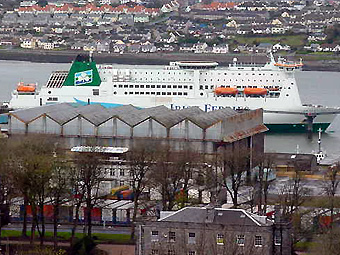
A passenger, unable to smoke in the restaurant, was leaning over the railing viewing the LNG tankship some 50 metres away in the narrow channel and provided a source of ignition. The subsequent fire destroyed the insulation in one of the ship's tanks, which then overheated and sprang its lid and then added its contents to the fire. The proximity of the high-sided car ferry contributed to the confinement, which together with the more explosive Algerian LNG led to a vapour cloud explosion of catastrophic proportions.
Not only were the casualties huge, but the entire harbour was closed. The gas tankship and the ferry sank and blocked the passage to Pembroke Docks. Oil tankers in the estuary were destroyed and the associated terminals damaged. The car ferry service lost a ship, its crew and its passengers. Yachtsmen were first asphyxiated, then burned.
Epilogue
In spite of local, vocal protestations, the fears of inhabitants were ignored. The experts examining the proposals ran sophisticated computer programmes in judging the risk potential but failed to imagine the sequence of events described above or the many other compounded occurrences that when coming together can lead to a catastrophe of huge consequences.
The enormous quantities of liquid gas involved should have rung a few alarm bells. There were other incidents, such as an LNG tank failure in Ohio (1944) which killed 225 people, a "rollover" in La Spezia, Italy (1971) caused a vapour leak which was not ignited. There was a release of vinyl-chloride vapour from the gas carrier Coral Acropora in the Manchester Ship Canal in 2004 when the ship's management systems failed.
But it was the physical arrangement of huge tanks sited on a hill above a terminal by a busy shipping lane that should have signalled the potential for disaster.